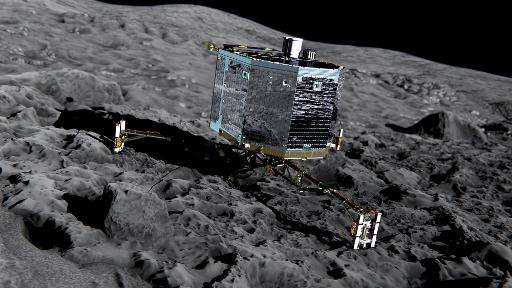New bid to contact Europe's comet probe

Europe will launch a new bid Friday to communicate with its comet lander Philae, hurtling towards the Sun some 360 million kilometres (224 million miles) from Earth, ground operators said.
Philae's orbiting mothership Rosetta will reopen communications lines for 10 days to listen for any call from the slumbering robot, Paris-based Rosetta project manager Francis Rocard of France's CNES space agency told AFP on Thursday.
Chances for contact improve daily as comet 67P/Churyumov-Gerasimenko draws closer to the Sun and its battery-replenishing rays, though the orientation of Philae's solar panels is unknown.
There had been two previous, unsuccessful attempts, in March and April, to contact the washing machine-sized probe, which fell silent three days after touching down on "67P" last November.
"We will listen anew from May 8-17," Rocard told AFP, but added a note of caution: "We cannot say with 100 percent certainty that it will wake up."
The 100-kilogramme (220-pound) robot lab touched down on the comet on November 12 after a 10-year trek piggybacking on its mother ship, Rosetta.
But instead of harpooning itself onto the dusty iceball's surface, Philae bounced several times before settling at an angle in a dark ditch.
The little lander had enough stored battery power for 60 hours of experiments, and sent home reams of data before going into standby mode on November 15.
As "67P" draws closer to the Sun, scientists hope better light will recharge Philae's batteries enough for it to reboot, then make contact, and ultimately carry out a new series of experiments.
But the window is shrinking.
By August 13 the comet will reach its closest point to the Sun, or perihelion, before veering off again into the deeper reaches of space.
If Philae hadn't woken up by August 14, it probably won't.
It's location on the surface of the dusty iceball has been narrowed down to an area of about 30 by 50 metres (98 by 164 feet). But Rosetta's cameras have not yet spotted the probe, and scientists don't know if it is upright.
Philae has to warm to at least about minus 45 degrees Celsius (minus 49 Fahrenheit) to wake up.
"Spring has sprung on the comet. The days are getting longer," Rosetta operations head Philippe Gaudon of CNES in Toulouse in the south of France.
"We hope to get about two or two-and-a-half hours of sunlight per day," for Philae.
© 2015 AFP




















